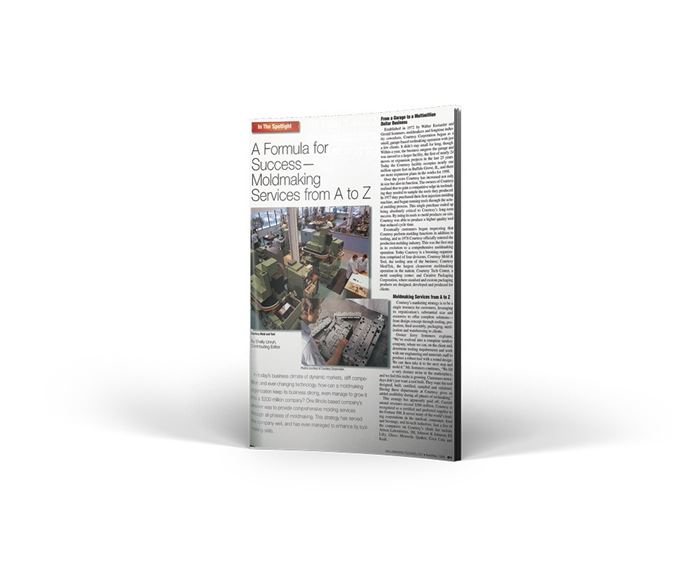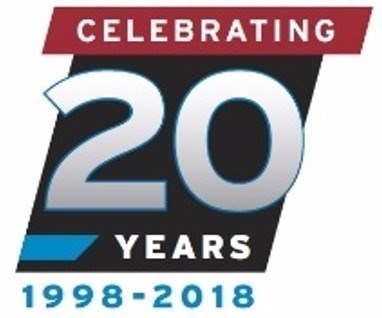Revisiting the MMT Spotlight with Courtesy Mold and Tool
For this special 20th Anniversary issue, MoldMaking Technology looks back at two of the first mold manufacturing companies to be profiled in 1998: Courtesy Mold and Tool and Delta Tech Mold.
Share
Read Next
Courtesy Mold and Tool (Courtesy) was the very first shop that MoldMaking Technology featured in a piece called “In the Spotlight” when the magazine launched in April 1998. A lot has changed in 20 years. In honor of the anniversary, MoldMaking Technology revisited Courtesy through past coverage and reflections from those who worked there.
First, a few basic Courtesy Mold and Tool facts from the 1998 piece:
- Walter Kreiseder and Gerald Sommers founded Courtesy Mold and Tool in 1972 as a garage-based moldmaking company with only a few customers.
- By the end of its first year in business, Courtesy outgrew the garage and made its first move to a larger facility. Over the next 25 years, many more moves and expansions followed.
- The company noted that its decision to sample the molds that it built in-house was critical to its long-term success. Courtesy purchased its first injection molding machine in 1977, and by 1978, it had launched its production molding operation. Customers liked the advantages that came with production molding services (they noted, for example, that higher quality tooling reduced cycle times), and this began the company’s evolution to a full-service moldmaking operation.
- When MoldMaking Technology featured the company in 1998, Courtesy already occupied a facility of nearly one million square feet in Buffalo Grove, Illinois. Courtesy Corp. was then the parent company of four divisions: Courtesy Mold and Tool (the division that built the molds), Courtesy Med/Tek (the division that was known at the time for being the largest cleanroom moldmaking operation in the United States), Courtesy Tech Center (the division that sampled the molds) and Creative Packaging Corporation (the division that designed, developed and produced standard and custom packaging).
- Courtesy’s customers in 1998 included Fortune 500 companies like Kraft, Coca Cola, Abbott Laboratories, 3M, Eli Lilly, Glaxo, Johnson & Johnson, Motorola and the Quaker Oats Company. Annual revenues reportedly exceeded $200 million.
Moldmaking Ahead of Its Time
MoldMaking Technology interviewed Courtesy in 1998. The magazine’s then contributing editor, Shelly Unruh, quotes Courtesy’s owner Jerry Sommers as saying, “We fill a very distinct niche in the marketplace, and we feel this niche is growing. Customers nowadays don’t just want a tool built. They want the tool designed, built, certified, sampled and validated. Having these departments at Courtesy gives us added credibility during all phases of toolmaking.”
Courtesy Mold and Tool prided itself on being a trend-setter, with its 180 moldmakers using the latest state-of-the-art technologies to build “close-tolerance, high-speed, high-cavitation tooling and its trademark, ultra-high cavitation stack tools.” The mold shop was equipped with MSI temperature controllers that it used to scan and control 165 zones within the plant to ensure excellent part quality and dimensional repeatability. Courtesy had its own, proprietary hot-runner system for molding polyolefin resins (95 percent of the molds that it built were hot-runner molds). Almost everything was computer-driven, including a CNC gun-drilling machine, five-axis vertical machining centers, lathes, wire and die sinker EDM machines and more. The company updated the equipment, on average, every seven years and trained the employees to use it. Sommers told MoldMaking Technology in 1998, “The moldmaker’s job has evolved from that of a pure craftsman into more of an assistant foreman position. He or she plans the job, guides it through, answers all the questions and makes sure that everything is done right and on time.” This teamwork concept set new standards for controlling how the company moved molds through the shop and for controlling how Courtesy kept customers up to date with one point of contact—the sales engineer.
Courtesy also blazed trails when it came to women in mold manufacturing. The company employed women “as mold designers, production engineers, mold polishers, inspectors and purchasing agents.” Sommers said in the 1998 piece, “We consider women as capable as men in moldmaking…and we focus on qualified employees whether they are male or female.”
An Employee’s Perspective
Kurt Mohrbacher, who is currently the operations manager at Janler Corp. (Chicago, Illinois), worked at Courtesy for 15 years and recently shared his perspective on what it was like working there before and during the acquisition years. “When I first went to Courtesy in 1994, I thought I would retire there,” he says. “It’s amazing how things can change in the world of acquisitions and mergers. I worked for 15 years in one place that changed its name three times.”
I learned so much there. I still consider that place to be the gold standard.
Mohrbacher recalls that Courtesy was the largest shop in the Chicago area. When he joined the team as a mold designer, the company had about 500 employees between the moldmaking and molding operations. “Wally (Kreiseder) liked employing people. He called it “horsepower.” He was the one who gave me the opportunity to move up when the current director of tooling retired,” he says. “He put together a great crew. Everyone I worked with at Courtesy was the best in the business. I learned so much there. I still consider that place to be the gold standard.”
In 1999, Hicks, Muse, Tate and Furst purchased Courtesy Corp. The firm, which had a controlling interest in Courtesy, seemed more interested in the molding operation than the tooling side, according to Mohrbacher. “Courtesy’s molding business was booming, and there were many products on the verge of production, including a dry-powder inhaler device that was expected to be a $20 million-a-year business all by itself,” he says. “The tooling operation was just an add-on.”
In 2002, Precise Technologies bought Courtesy Corp. At the time, the investment company Code, Hennessey and Simmons owned Precise Technologies. Mohrbacher, who was director of engineering, was part of a group of employees that had to consolidate all the equipment that Precise Technologies had in its Des Plaines, Illinois, shop with equipment that Courtesy had in a small, Lake Geneva, Wisconsin, mold shop. They had to move everything into the main moldmaking facility (known as the 800 Building) in Buffalo Grove. “Precise Technologies had a toolroom, so they understood tooling and liked the idea of it supporting their molding business,” he says.
Another Acquisition, Another Name Change
In 2006, U.K.-based Rexam PLC acquired Precise Technologies (including Courtesy Corp.) and renamed it Rexam Mold Manufacturing. MoldMaking Technology again featured the company in 2008, emphasizing the continued focus on manufacturing high-cavitation, tight-tolerance production molds for medical, caps and closures, home and personal care products under the new organizational structure. Mohrbacher moved from the tooling department in the 800 Building across Deerfield Parkway to the 600 Building, which was dedicated to pharmaceuticals with product design and development, molding and assembly. He worked there as a new product development engineer. “We had a kind of campus made up of three large facilities in Buffalo Grove. The 700 Building housed the Creative Packaging division. There was also a plant in Wheeling, Illinois, that was all medical molding,” he said. Mohrbacher left the company in 2009, but he keeps in touch with several former coworkers.
Tom Worcester worked at Courtesy and then Precise Technologies. He became Rexam Mold Manufacturing’s sales manager for mold manufacturing and was interviewed for the 2008 feature. According to Tom, the Rexam organization was a leading aluminum can manufacturer for the beverage industry but split the company to pursue the global plastics packaging market. Two distinct business units, FasTrack and Production Tooling, were created out of the mold manufacturing division that Precise Technologies had in place. Rexam also transformed it from a support center to a primary business unit. “The FasTrack group is dedicated to producing molds that are production-ready molds but typically with lower cavities (two to eight, sometimes 16). These molds are totally representative of how the production molds will operate and produce product,” Worcester told MoldMaking Technology in 2008. “The production side of the business lends itself to the full production molds—ranging from large stack molds, high-cavity molds, up through 192 cavities to complex, multi-material applications to fill the needs of our clients.”
Worcester said that in a similar fashion to Courtesy before the acquisitions, Rexam believed in keeping up with the latest technologies and equipment and made sure employees continually developed their skills. “The incorporation of fully integrated machining centers that can operate 24/7 unattended combined with the development and implementation of better and faster work processes has led to faster deliveries—which means less time in the shop and faster approval of production-ready molds,” he told MoldMaking Technology in 2008.
Eventually, Rexam broke up and sold off various divisions of the company. In June 2011, Rexam sold its caps and closures business to Berry Plastics, which included most of the packaging operations and the entire mold manufacturing operation. In 2014, Lynx Medpak, a subsidiary of Flextronics International (now called Flex), acquired the molding assets and the whole 700 Building from Berry Plastics. In the deal, Flex got the advanced “Mega-Cell” automation technology that Rexam Mold Manufacturing created. Mohrbacher says that Flex eventually purchased the moldmaking assets from Berry Plastics too. Flex also acquired Tech Mold in Arizona the year before. Numera from Novatek now owns the 600 Building, with its pharmaceutical division. Numera is a manufacturer of personal safety and proactive wellness products.
While Courtesy Corp. saw the retirement of its original owners and many subsequent changes in proprietorship, name and structure, its story does not end tragically. Rather, it makes for an historic portrait of a company’s evolution, via acquisitions and equity investment companies, that the industry continues to see today.
Get Social and Be a Part of the 20th Anniversary Coverage with #MMTMag20 on
Twitter, LinkedIn and Facebook.
Related Content
Think Safety: Eliminate Hazards Throughout the Shop
The tooling community is taking advantage of new products for safer mold shops and molding facilities.
Read MoreWhat is Driving Mold Lifecycle Management Digitalization?
OEMs are looking to partner with suppliers to share and track data across the supply chain for advanced intervention and process management.
Read MoreHow to Improve Your Current Efficiency Rate
An alternative approach to taking on more EDM-intensive work when technology and personnel investment is not an option.
Read MoreEditorial Guidelines: Editorial Advisory Board
The Editorial Advisory Board of MoldMaking Technology is made up of authorities with expertise within their respective business, industry, technology and profession. Their role is to advise on timely issues, trends, advances in the field, offer editorial thought and direction, review and comment on specific articles and generally act as a sounding board and a conscience for the publication.
Read MoreRead Next
How to Use Strategic Planning Tools, Data to Manage the Human Side of Business
Q&A with Marion Wells, MMT EAB member and founder of Human Asset Management.
Read MoreAre You a Moldmaker Considering 3D Printing? Consider the 3D Printing Workshop at NPE2024
Presentations will cover 3D printing for mold tooling, material innovation, product development, bridge production and full-scale, high-volume additive manufacturing.
Read MoreHow to Use Continuing Education to Remain Competitive in Moldmaking
Continued training helps moldmakers make tooling decisions and properly use the latest cutting tool to efficiently machine high-quality molds.
Read More






















